The (half-price) play’s the thing with LA Stage Alliance
July 15, 2010
It’s a common complaint: Where’s the live theater in L.A.? Everything is movies and television. It’s true that we’re not New York and there’s no Broadway, off-Broadway or even off-off-Broadway. But L.A.’s best-kept performing arts secret is a vibrant and flourishing small-venue theater scene that dwarfs most of its competition elsewhere in the nation – including the Big Apple.
Since 1988, the non-profit LA Stage Alliance (LASA) has functioned as a kind of one-stop shop for live-theater aficionados, dedicating itself to building awareness, appreciation and support for the performing arts in Greater Los Angeles. Today, LASA (with financial support from the County of Los Angeles, among others) serves and supports more than 325 local producing and presenting performing arts organizations in Los Angeles and five surrounding Southern California counties.
And since 1999, LASA has operated the region’s leading online half-price ticketing service, LAStageTIX – a win-win enterprise that offers avid theatergoers substantial half-price discounts on a wide range of presentations, and gives LASA’s member companies choice opportunities to boost their box office and generate some buzz around their productions.
Here’s a sampling of just a few of the shows on offer this week in North Hollywood’s NoHo Arts District venues:
The Raven Playhouse at 5233 Lankershim Blvd. in North Hollywood revives the classic debut work by playwright Arthur Miller, which earned a Tony Award for Best Play of the Year in its 1947 premiere run. A dark study of the stress and conflict shadowing the American dream in post-war America, Miller’s scathing exploration immediately announced the arrival of a major new talent in the theatrical world. The intervening decades have dulled none of its dramatic power or political and social relevance.
The Chandler Studio Theatre Center at 12443 Chandler Blvd., North Hollywood brings to life a dynamic new production of Peter Shaffer’s celebrated Tony-winning tale of the lethal rivalry between the brilliant but fragile Wolfgang Amadeus Mozart and his jealous and scheming competitor, Antonio Salieri.
Beyond is a unique production, billed as the first of its kind in Los Angeles, that conjures of up visions of classic French cabaret variety shows, featuring exotic world-class performers including dancers, aerialists, acrobats, and of course a sultry chanteuse. The venue is the celebrated El Portal Theatre at 267 Lankershim Blvd, North Hollywood.
Posted 7/15/10
Phone audit delivers wake-up call
July 14, 2010
Here’s one phone number Los Angeles County officials would rather forget: $3.5 million.
That’s how much money was being spent annually on unused phone lines across the county bureaucracy—20,906 of them—according to a new report by the county’s Chief Executive Office.
CEO William T Fujioka said the amount spent on these lines could rise to as much as $4 million as the county moves toward completing its “zero usage project,” part of a multi-faceted initiative to reduce waste and inefficiencies.
Fujioka said he knows the county is open to criticism for not recognizing sooner that unused lines were a potential source of wastefulness. “But the worst thing that could have happened,” he said, “is that the audit would not have happened at all.”
The phone line audit targeted every agency, big and small, of Los Angeles County government. In some instances, the savings amount to just a few hundred dollars, as in the case of the Office of Ombudsman, which disconnected service to two of its total five lines, saving $339.12 a year.
Then there’s the massive Department of Public Social Services, which so far has cut service to 3,791 lines out of 6,633, for an annual savings of $600,478. (For the complete rundown of department savings, click here.) DPSS Director Philip Browning said that while some of the unused lines can be traced to office moves and the loss of 1,000 staffers, complacency also is to blame.
“I think we take so much for granted,” said Browning, who praised the county’s focus on waste. “When times are tough and budgets are tight we’re forced to think about things in a different way. We don’t have the luxury to continue in the same way as when things were better.”
Browning said the audit put even him on the spot. When he moved into his office after being appointed a few years back, there were two phones, one of which rang only when it was a wrong number. “I never even thought about it,” Browning said. “I’m sure there was a good reason at some point in time for someone to have both phones. It could have been years and years ago.”
Credited for coming up with the audit idea is Thomas Tindall, director of the Internal Services Department. His agency pays the bills for the county’s roughly 200,000 lines. Tindall, who helped prepare the CEO report, called the phone study a “good news, bad news, kind of thing” because, although the county aggressively uncovered the problem, it should have been discovered earlier.
“I really cringed when I had to prepare the [CEO] memo because I knew the media might be calling,” Tindall said.
The study was a huge and time-consuming undertaking, with every department being given a list of numbers for which there’d been no “outbound usage.” Then, it was up to the departments to determine whether the lines were being used—a task not quickly embraced by everyone, said Robert Aragon, who managed the project for ISD.
“I would say it was viewed as a lower priority,” Aragon said. “What ultimately helped, the CEO’s office applied some pressure and told them to get it done.”
And that push may help get them ready for what’s on deck.
“Next, we’re going to look at printers. We have over 70,000 of them,” said CEO Fujioka, adding that toner doesn’t come cheaply.
Posted 7/14/10
Vintage comedies at LACMA
July 14, 2010
LACMA’s “Laughter in Paradise: the American Comedies of Ernst Lubitsch” film series continues this weekend with screenings of four of the comedy director’s best movies.
Famed for his elegant, sophisticated comedies, the Berlin-born director was known for imparting a special zest that came to be called “the Lubitsch touch.” Acclaimed comedy director Billy Wilder called Lubitsch “the most elegant of screen magicians.”
Friday night’s first offering is “Design for Living” (1933), the earliest screwball comedy, starring Gary Cooper and Frederic March as a pair of men in Paris vying for the love of the same girl. Next comes “The Smiling Lieutenant” (1931), an Oscar nominated musical with Maurice Chevalier and Claudette Colbert.
On Saturday, moviegoers can catch “The Shop Around the Corner” (1940), starring James Stewart and Margaret Sullavan as quarreling co-workers in prewar Budapest who, without knowing it, are busy penning anonymous love letters to each other. “Among the greatest of films,” film historian and critic David Thomson says. Following that is “Angel” (1937) starring Marlene Dietrich as a bored wife who has a quick affair with a man who turns out to be her husband’s old friend.
Check out descriptions and screen times at LACMA’s site, here.
Posted 7/14/10
Bugs (and friends) at the Bowl
July 14, 2010
 Didn’t get enough fireworks on the 4th? How about enjoying another sparkler show at the Hollywood Bowl in the company of the Los Angeles Philharmonic and that high-toned but wascally wabbit, Bugs Bunny?
Didn’t get enough fireworks on the 4th? How about enjoying another sparkler show at the Hollywood Bowl in the company of the Los Angeles Philharmonic and that high-toned but wascally wabbit, Bugs Bunny?
Running Friday and Saturday, the “Bugs Bunny at the Symphony” show will screen classic Warner Brothers cartoons as the Phil plays the fabulous scores. In addition to Bugs, the lineup includes Looney Tunes episodes and animated shorts starring Tom and Jerry, Scooby Doo and the Flintstones.
Catch “What’s Opera, Doc?” as Bugs runs rings around The Ring Cycle. The Bowl itself is a star of the Tom and Jerry episode as Tom, in black tails, conducts a cat orchestra at the famous band shell as his mouse friend provokes major disruptions.
All that and fireworks, too.
Posted 7/14/10
Big blankets vs. 405 night noise
July 14, 2010
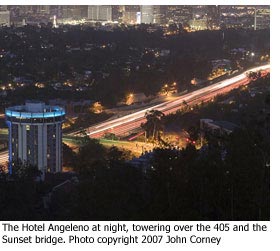 Demolition work on the Sunset Bridge over the 405 Freeway will take place within a massive cocoon of sound blankets—some 30 feet long and suspended from cranes. Others will be draped from the back side of the bridge, while additional blankets will encase concrete barriers around the site as the south side of the bridge is dismantled piece by piece on six consecutive nights.
Demolition work on the Sunset Bridge over the 405 Freeway will take place within a massive cocoon of sound blankets—some 30 feet long and suspended from cranes. Others will be draped from the back side of the bridge, while additional blankets will encase concrete barriers around the site as the south side of the bridge is dismantled piece by piece on six consecutive nights.
The sound absorption blankets—all 6,000 square feet of them—are a bit of “pre-emptive mitigation” that officials hope will help muffle some of the expected noise from the project, which, after weeks of prep work, is about to enter the bridge demolition phase on July 23.
“We’re basically encircling the site with sound blankets,” says Devon Cichoski, Metro’s community relations manager on the project to add a 10-mile northbound carpool lane to the 405 Freeway, along with other improvements. “The idea is you kind of encase the bridge in these sound blankets and less noise is escaping into the community.”
Nighttime construction noise is allowed up to 86 decibels, as measured 50 feet from the site.
“Could it still be loud with all that stuff up? Absolutely,” Cichoski says.
So people with urgent noise complaints—or other emergency issues—are encouraged to call the project’s hotline number, (213) 922-3665.
Operators (well, Metro community relations staff) really will be standing by, Cichoski says. After-hours callers will be connected to a line that provides the cell phone number of that night’s on-call representative. Callers with more routine comments or questions can leave a message. The hotline also offers a recorded rundown on each day’s lane and ramp closures.
For a look at all the planned freeways and street closures—and recommended detours—during the Sunset Bridge demolition work, check out this construction notice and attached map.
The Sunset Bridge is the first of three bridges over the freeway that will be demolished in sections and reconstructed in new-and-improved form during the course of the project. (The others are at Skirball Center Drive and Mulholland Drive.)
After the south side of the Sunset Bridge is rebuilt—which should take about 10 months—the process will be repeated on the north side. The bridge will have four lanes open to traffic during construction—two in each direction.
Read our earlier story about the Sunset Bridge work here.
Local arts grants ripple out
July 14, 2010
Money’s tight these days—which makes being on the receiving end of a grant from the Los Angeles County Arts Commission that much sweeter. That’s doubly true of some of the non-profit organizations receiving funds for the first time.
The grant newbies include the Buzzworks Theater Company, the Invertigo Dance Theatre, the Los Angeles-St. Petersburg Russian Folk Orchestra and the Madison Project, an independent nonprofit that puts on cultural programs at the Broad Stage on the Santa Monica College campus.
“We weren’t sure, with times being what they are, that we were going to get anything,” said Deborah Reed, Buzzworks’ director of development, which will use its $4,000 grant to pay its artists. “We’re just thrilled.”
In all, the commission awarded $4.1 million in two-year grants to 166 organizations across the county. The grant amounts are smaller this year, but were enhanced somewhat by the Board of Supervisors, which recently voted for a one-time infusion of funds from county reserves to help bridge the shortfall.
The full list of 3rd District groups receiving grants is here. They range from the Topanga Symphony, which received $3,500 for its free concert series, to the Skirball Cultural Center, granted $141,682 to support its Sunset Concerts program.
L.A. Coroner gets some hi-tech help
July 14, 2010
It’s a “CSI” world out there. But when it comes to in-house DNA testing, the L.A. County coroner’s office might as well be back in the “Quincy” era.
That’s about to change. Armed with start-up funding from the county’s Quality and Productivity Commission, the department is embarking on a plan to create its own small DNA lab. The department will hire expert consultants who will help it establish an accredited lab that can help coroner’s officials solve some of their toughest cases—and perhaps even turn a profit.
The proposal for the lab, which will be funded for three years with $1.6 million annually from the commission’s Productivity Investment Fund, was approved by Los Angeles County Supervisors on Tuesday.
Anthony T. Hernandez, director of the coroner’s department, said establishment of the lab is “way overdue.” New York City’s Office of Chief Medical Examiner has the largest coroner’s DNA lab in the country, and has been performing such testing since 1991.
In L.A. County, a primary function of the new lab will be to shortcut the often time-consuming—and sometimes futile—work of identifying the 350 to 400 John and Jane Does who come through the coroner’s office annually. There are at least 25 such “hardcore” cases that elude investigators each year, Hernandez said.
Having a DNA lab also will allow coroner’s officials to take on the 100 or so paternity requests it receives each year. These often come from people trying to claim Social Security or other benefits for children of people who have died. As it stands now, their requests must be farmed out to private DNA analysis firms.
Others turn to the coroner’s office seeking paternity information that will help them come to terms with mysteries that have haunted them all their lives.
“It does fill an emotional void for a lot of folks,” Hernandez said.
Once the lab is up and running, the coroner’s office says it also will be able to assist law enforcement agencies struggling with a backlog of cases, including large numbers of untested sexual assault kits that have plagued agencies such as the Los Angeles Sheriff’s Department.
“We don’t profess to make a giant dent in that, but we think we could help,” Hernandez said.
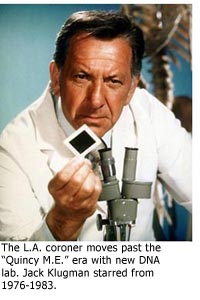 Dr. Lakshmanan Sathyavagiswaran, the county’s Chief Medical Examiner/Coroner, said he’s excited about the possibilities of the new lab from an investigative standpoint.
Dr. Lakshmanan Sathyavagiswaran, the county’s Chief Medical Examiner/Coroner, said he’s excited about the possibilities of the new lab from an investigative standpoint.
“I’m all for it,” Sathyavagiswaran said. “We’ll be a full-service department.”
Sathyavagiswaran, in an interview outside the Board of Supervisors hearing room, said the new lab will be helpful in “subtle cases where it’ll enhance the quality of death investigation.” Those cases include deaths by Long QT Syndrome, in which the heart stops for no obvious reason, such as in an apparently healthy high school athlete. DNA testing also could be useful in uncovering hidden crimes in cases where the cause of death was obvious–for example, a woman who’d died of a heroin overdose but also may have been the victim of a rape before her body was dumped.
“The citizens of L.A. will benefit from this DNA laboratory,” Sathyavagiswaran said in a follow-up email.
With 18,000 deaths reported to the L.A. County coroner’s office each year, it ranks as one of the world’s busiest, with responsibility for investigating thousands of violent or unusual deaths each year, along with notifying next of kin and determining how and why deaths occurred.
Dr. Jeffrey Jentzen, a chair of the National Association of Medical Examiners’ committee on inspections and accreditation, said it makes sense for L.A. to join other major jurisdictions like New York and Houston in having an in-house coroner’s DNA lab.
“The quicker you can make identifications, the better you can keep the flow of bodies moving and avoid backups,” Jentzen said.
There are also financial incentives, according to Hernandez. He said the lab is expected to generate revenue from paternity testing and from collecting fees from law enforcement agencies and smaller coroner’s offices seeking help with their cases.
“We have been working on the implementation of DNA testing since late 2006,” Hernandez said. One reason it took so long is that the department tried to find a way to establish the new lab “in a way that doesn’t cost the county anything.”
The seed money from the productivity commission fund, he said, will enable the department lab to start small and grow into a self-supporting and eventually profitable endeavor.
It also could help the department keep up with the expectations of the television-watching public. Said Hernandez: “You’d be surprised how many folks do think ‘It’s the coroner. It’s just like CSI.’ “
Posted 7/14/10
New funds for Westside homeless agencies
July 13, 2010
Federal housing officials last week awarded more than $4.7 million in housing subsidies to three Third District non-profits that are developing cutting edge programs to house the chronically homeless.
The winners of the competitive “Shelter Plus Care” grants were the Venice Community Housing Corporation, Step Up on Second and Ocean Park Community Center, or OPCC.
The grants from the federal Department of Housing and Urban Department provide apartment rental subsidies, or vouchers, for a five-year period. To qualify, the providers must match the value of the vouchers with spending on health care, case management or other services.
All three winning organizations are committed to the concept of permanent supportive housing—combining long term residences with customized health care and social services for homeless people with the greatest risk of dying on the streets. In Los Angeles County, this approach is the hallmark of the successful Project 50 on Skid Row. Since then, programs based on Project 50 have spread to Santa Monica, Venice, Long Beach, West Hollywood and Van Nuys.
“People are homeless because they have underlying problems that, if not addressed, will keep them homeless,” says Howard Katz, a commissioner with the Los Angeles Homeless Services Authority, which will distribute the new funding. “These three organizations have shown that they understand this relationship and know how to effectively address it.”
In addition to the three grants to non-profits, the City of West Hollywood received $1.25 million and the County’s Department of Mental Health $4.13 million in Shelter Plus Care funding.
Here’s how executives of the Third District non-profits say their organizations—and their homeless clients—will benefit from the infusion of rental subsidies:
 Steve Clare, executive director of the Venice Community Housing Corporation, which provides housing and services to low income individuals. The organization received $1,133,220.
Steve Clare, executive director of the Venice Community Housing Corporation, which provides housing and services to low income individuals. The organization received $1,133,220.
“That money will allow us to house 20 homeless people with disabilities who have essentially no income. They’ll live at a new project of ours. It’s called Horizon Apartments, and it’s a 20-unit building we’re renovating that’s located a half block from the beach. It’s a beautiful building; it used to be a short-term tourist hotel and it needs relatively little renovation. We hope we’ll have the building ready next winter. The residents will receive case management and other services, and we’ve contracted to provide mental-health services. We have the building and the services lined up, but the rental subsidy this grant provides is critical. Without it, we’d have to be charging residents $800 or $900 a month per person to cover our basic operating costs. The project would be impossible.”
 John Maceri , executive director of OPCC, a Westside provider that operates shelters and “housing first” programs for the chronically homeless. The organization received $1,659,900.
John Maceri , executive director of OPCC, a Westside provider that operates shelters and “housing first” programs for the chronically homeless. The organization received $1,659,900.
“The award is for 40 vouchers and it’s an enormous boost to our ability to house people. It allows us to continue to expand our services to more of the at-risk homeless who have the most to lose by remaining on the street. Ours is a scatter-site application, meaning that we find apartments for clients all over the area, not in a particular building. We already have about 300 units now. We’ll be working with chronically homeless single adults living with multiple disabilities, from mental health to substance abuse issues and chronic health problems. About 35 percent of the folks we serve are seniors. The length of time on the street ranges from six to 30 years, with the average at 12 years. We have staff who will be intensely involved helping the new clients locate units. I hope we’ll have a start date in the fall.”
 Tod Lipka, chief executive of Step Up on Second, a Santa Monica mental health provider, which is launching a new Step Up on Vine project in Hollywood. The organization received $1,980,300.
Tod Lipka, chief executive of Step Up on Second, a Santa Monica mental health provider, which is launching a new Step Up on Vine project in Hollywood. The organization received $1,980,300.
“We’re converting a three story motel on Vine Street into a 34-unit permanent supportive housing facility for homeless people living on the streets of Hollywood. We acquired the building in August 2009 for $3 million. Our timetable is to begin construction in June 2011 and open in June 2012. We’ll be housing chronically homeless people with mental health disabilities. It’s typically schizophrenia, bipolar disorder or major depression. All of these people will be very low income. The vouchers…are really necessary to cover the gap between the small amounts the residents can pay, which is 30 percent of their income, and the actual operating costs. We’re going to provide ongoing support because housing is a big transition for people who have lived on the streets long-term. As one of our clients said, ‘Getting housing is just the first step’.”
Posted 7/13/10
Zen and the art of preschool teaching
July 13, 2010
No longer are preschool teachers the unsung heroes of education, at least not in L.A. County. On Tuesday, the Board of Supervisors honored the winners of the third annual “Preschool Teacher of the Year Awards.” The six winners were picked by the non-profit Los Angeles Universal Preschool, or LAUP, whose goal is to ensure that every four-year-old in the county receives a high-quality preschool education.
“What all these teachers have in common is an unquestioned commitment and dedication to the children in their classrooms, where they go beyond the call of duty to provide their students with a quality early childhood education that will last a lifetime,” says LAUP Chief Operating Officer Celia C. Ayala.
This year’s Third District winner is head teacher Claudia Araujo of Vanalden Early Education Center in Reseda, where she also facilitates workshops for colleagues, leads meetings for parents on education and development and presents grant proposals. Among her many contributions, Araujo received a $2,500 grant to improve early literacy and math programs at the school and organized a parent lending library.
An interview with the soft-spoken and thoughtful Araujo quickly turned into a session that seemed as much about how to make an emotional connection with children as about how to create a curriculum for them. (For a video of Araujo in action, see below.)
Here’s a taste of what this teacher has learned along the way:
Winning is exciting, but naptime is even more important.
“I got a phone call at work… letting me know that I had won. I mean at first I couldn’t believe it, I was just ecstatic. The children were napping so I couldn’t be loud and I had to step outside and talk to her on the phone. It was really, really exciting.”
Follow your childhood passion.
“Ever since I was little, I always was fascinated with being a teacher, I would pretend to be a teacher, I would play teacher. I like that feeling you get when you are teaching somebody something. As a school girl I used to think this is a wonderful career, this is a wonderful thing to do.”
Be calm and have patience; children will listen.
“We do have children who come in with different challenges. And I see that in order to get across to that child, I will really have to understand the child, I will really have to talk to them. I have to be very calm. I have to be patient. Right away I start talking to the child in a way that’s really calm and really patient, letting him know that things are going to be fine. Sometimes people don’t understand that you have to talk to a child really calmly and when you do that the child responds.”
The best teachers are also students; education is a lifetime endeavor.
“Advice I would give new preschool teachers is to always be patient, get to know the children, and learn as much as you can with ongoing education. Every time you learn something in a class, then you see it at work and it becomes your own, it becomes your own technique. The more that you’re researching, the more that you’re learning. All those little things will help you in the classroom and will help you develop as a teacher, too.”
Be who you are and have fun.
“You want to have fun, be creative, be artistic. The children will love all that. If you are a dancer, dance with the children. Even if you aren’t a good dancer, even if you are moving, the children will love that. Sometimes you may think that you don’t have the right skills, but you already do. You just have to be able to say, I may not be perfect, but I’m willing to try.”
A teacher’s greatest reward is the success of her students.
“One of my former students came back and she was so excited showing me her 5th grade diploma. When she came in she gave me a hug and said, ‘Ms. Araujo, you were my first teacher!’ Her mother said, ‘You know I had to bring her, she wanted to take a picture with you and her diploma. She’s always thought of you as her very first teacher and you made such a positive influence on her.’ It was really emotional for me because it was so exciting to see that I make a difference.”
Success is rarely achieved alone.
“I am really excited and happy to have won this award because I do like teaching. But I’d also like to say as a teacher, you also need your staff and your paraprofessionals at your side with you. We’re able to work well together, we’re able to share lessons and talk about what our lesson plan is. And once you have that connection and know you are able to work as a team, then everything becomes easier because you know you have support.”

Posted 7/13/10




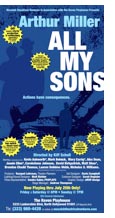




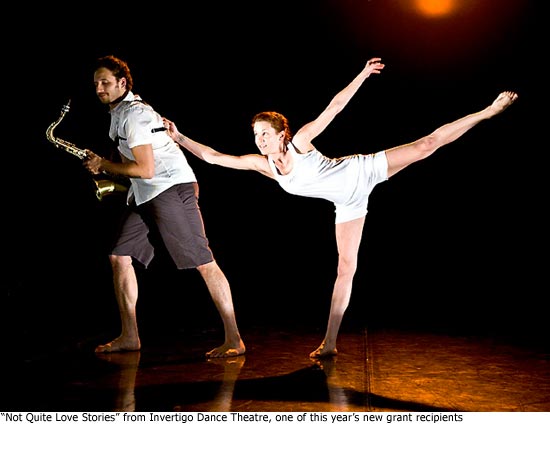


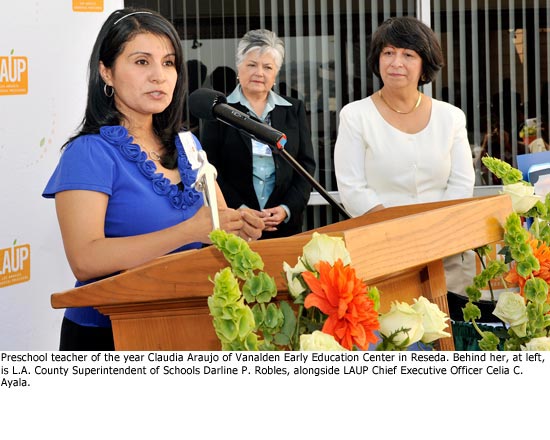





 Check for the latest closure information
Check for the latest closure information








